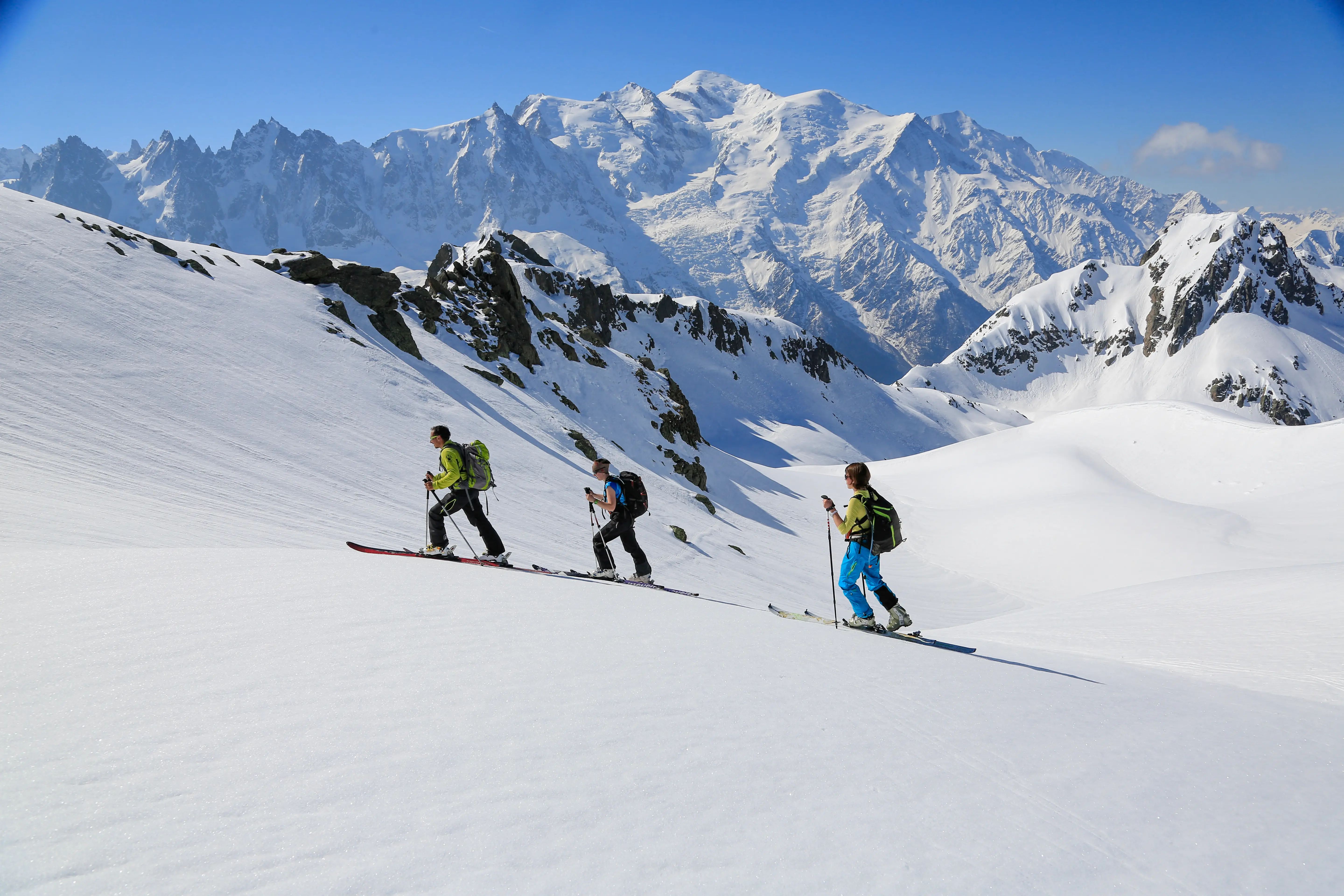What is ski mountaineering?
The ski mountaineering, sometimes referred to as ski touring When practiced as a hobby, is the art of moving in the mountains or High mountain using skis to get on and off various routes. But how do you ski up a hill? Skis adapted to ski mountaineering are used, equipped with special bindings that leave the heel free during the ascent, just like cross-country skiing!
To avoid backing up when climbing, the skier attaches “seal skins” under his skis, synthetic anti-recoil bands. Once at the top, the skier removes these skins, locks his heel and the descent feels like a session of backcountry skiing, in an eternal quest for fresh snow.
It is an optimal mode of travel in snowy regions with terrain. Thanks to the buoyancy of the skis, the skier avoids getting engulfed in the snow while being able to navigate on terrain that is sometimes very inclined. The land suitable for this activity is vast, ranging from areas surrounding ski resorts to the highest peaks in the world. In harmony with the environment, the ski mountaineer leaves behind only the ephemeral traces of his passages in the snow.
Equipment, equipment and safety: the rules of ski touring
Outfit
Unlike the alpine skier, the backcountry skier opt for specific outfits to manage the climb and ensure your safety. With the cold winter and the physical demands of the ascent, the choice is made for breathable and spacious clothing, possibly including a change of clothing.
Typically, the ski mountaineer uses the three-layer system: a first breathable thermal layer, a second insulating layer like a fleece, and finally a waterproof and windproof outer layer. In competition, the outfit tends towards lighter, stretchy and often more expensive materials, with the possibility of personalization, such as logos or colors.
Equipment for the ascent
Les touring skis similar to alpine skis but are lighter. Skis specifically designed for ski mountaineering are even lighter, suitable for competitions. To avoid slipping during the ascent, “seal skins” are used, formerly made of real seal fur and now mostly made of mohair or synthetics.
The shoes are more flexible than those of downhill skiing, with a detachable heel to facilitate walking. Ski mountaineering models are often made of carbon for lightness. Bindings vary between traditional alpine bindings, lightweight insert bindings or even more minimalist competition models. For difficult terrain, knives can be added to prevent skidding.
A specific backpack to carry skis, an ice axe and crampons can be useful. To optimize the glide and avoid the accumulation of snow, it is advisable to wax the skis and skins.
Equipment for the descent
The bindings lock to imitate the sensations of downhill skiing. Although versatile, these skis can vibrate on hard snow. They often have a notch to attach sealskins and sometimes a hole for various uses in the mountains.
security
Evolve in the mountains in ski mountaineering requires a thorough knowledge of the terrain and weather conditions. It is essential to consult the meteorological and snow services before leaving. The weight of the safety equipment also increases the load of the bag, reinforcing the sporting aspect of the activity.
It is strongly recommended to bring:
- orientation tools such as GPS, compass, altimeter and maps;
- weather and snow equipment;
- equipment for difficult terrain (ropes, ice ax, helmet, and sometimes a harness for certain competitions);
- the essential trio (DVA, snow shovel and probe);
- means of communication;
- a first aid kit;
- tools for quick repairs (screwdrivers, pliers, Swiss Army knife, etc.).
Ski mountaineering races: the essentials
If you want to get started in ski mountaineering, here are some essential ski mountaineering races:
- The Alpi Ski Tour : it is a racing circuit organized every winter season by the various clubs. There are two national championships, individually or as a team.
- The Vertical TransVanoise : it is the only ski mountaineering race on a glacier in France.
- La Pierra Menta : this race takes place every year in the Beaufortain massif, towards the eponymous summit.
- The Great Trace : it is a wild and technical ski mountaineering race in the Southern Alps. It is located in the heart of a unique mineral massif, Le Dvoluy.




